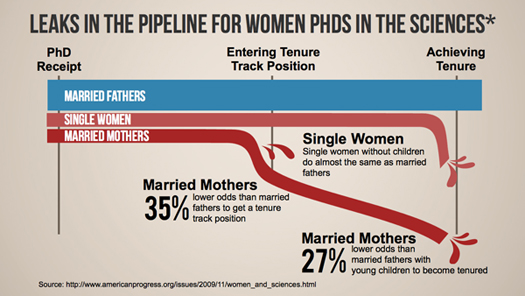
Being a professor is easy, right? We have summers off, and we teach 1-2 classes per semester. When we’re not teaching, we’re lounging in our big offices and wondering about our next book contract or grant proposal. If we’re busy with writing that new book or attending a conference in some exotic location, we farm out the grading and teaching to our TAs. This low stress level is a major perk of being a professor. Or so CareerCast’s “Least Stressful Jobs of 2014” and “Least Stressful Jobs of 2013,” as well as a Forbes piece about the 2013 CareerCast study, would have it. But what about the roughly 70% of higher education faculty—the true new faculty majority—who lack the “lucrative prospects” (as the former terms it) and kinds of conditions CareerCast and Forbes seem to think most professors have? How “easy” is it for the professors who, for instance, teach at three different schools (sometimes in the same day) and still earn poverty-level wages?
 The ever-increasing number contingent university faculty—over a million and rising—does not share this “low stress” lifestyle. (Neither do tenured and tenure-track faculty, but I won’t speak for them.) Contingent faculty do not have teaching or research assistants, paid sabbatical leave, small upper-level classes in their area of expertise, or course releases to ease the teaching workload. Many are paid poverty-level raises and essentially hit the reset button at the beginning of every semester—the same short-term contract, the same pay scale, the same lack of basic faculty rights. It’s sometimes hard to feel stable in and dedicated to a school when your contract doesn’t extend past the current semester, or if you split your time and attention when you also teach at two others.
The ever-increasing number contingent university faculty—over a million and rising—does not share this “low stress” lifestyle. (Neither do tenured and tenure-track faculty, but I won’t speak for them.) Contingent faculty do not have teaching or research assistants, paid sabbatical leave, small upper-level classes in their area of expertise, or course releases to ease the teaching workload. Many are paid poverty-level raises and essentially hit the reset button at the beginning of every semester—the same short-term contract, the same pay scale, the same lack of basic faculty rights. It’s sometimes hard to feel stable in and dedicated to a school when your contract doesn’t extend past the current semester, or if you split your time and attention when you also teach at two others.
When I wrote about these struggles for Hybrid Pedagogy back in October, I noted that students suffer when we can’t meet with them because we’re teaching at another school when they’re free, or when their drafts are in a pile of 60-70 (or more) we have to grade. Once they’re on the same campus as their students, contingent faculty can struggle even more because some lack office space, or share one with 4+ other professors—and sometimes no working computer or printer. Try talking with students about their writing and/or grade anxieties with other professors—and other students—in the same small space. Anyone who thinks being any kind of professor isn’t stressful simply hasn’t been paying attention to what higher education is becoming in this country.
On our campuses and social-media platforms, we have a strong, ever-growing community of contingent faculty eager to speak out, collaborate, and increase solidarity on both sides of the tenure track. Find them; read their work; build community with them and others like them. (I’m a teacher, so I can’t resist giving my audience reading assignments.) Here are just a few recent pieces from them:
- Elizabeth, Keenan: “How To Be a Tenured Ally”
- Rebecca Schuman: “Horrible Job-Market Platitudes (and How to Retire Them)”
- Lee Skallerup Bessette: “On Contingency, Vocation, and Loyalty”
- Mary Grace Gainer and Brianne Bolin trading interviews: “Adjunct Moms, Adjunct Breadwinners”
- William Pannapacker interviewing Alex Kudera: “The Novelist Who Chronicles Life as an Adjunct”
Have a look also at Josh Boldt’s Adjunct Project; he’s recently done a review of 2013 top posts, with more strong work to come in 2014. Among other things, you can add data about your salary and general treatment from your school(s). These are some of the many wonderful, engaging minds writing about different facets of contemporary labor and higher education.
As I stressed in Chronicle Vitae back in October, contingent faculty should be helping themselves by connecting with others, seeking unionization, bonding with (sympathetic) tenured or tenure-track professors, and generally understanding that we should be the ones revising and expanding the contingent narrative. Speak out, or be spoken for by a university administration that likes you right where you are.

I’m at a private university and enjoy (at some level) privileges and protections faculty at public universities do not—first and foremost being unionized through SEIU and having collective bargaining. Although I wasn’t an active organizer, I was working at GW during unionizing efforts in the early 2000s.
Then as well as now, teamwork and solidarity led to success. Contingent faculty worked together and communicated—both during the collective bargaining process and when (as expected) the university stonewalled, challenged the validity of petition signatures, and otherwise tried to forestall the process.
Everyone Has Stress Points
For any full-time, tenured faculty professor reading this, listen to Elizabeth Keenan: Reframe your understanding of the “adjunct problem” as the creation of a long-term, growing academic underclass, rather than a temporary setback for a few individuals. We’re talking here about how universities have effectively created a permanent faculty underclass—some of whom don’t even have a regular office or library privileges to aid their teaching.
I’ll add this to Keenan’s directive: we’re in this together. The more we see how these issues (and solutions) affect contingent and tenured/tenure-track faculty, the more we’ll see how much “faculty working conditions are student learning conditions,” as New Faculty Majority and others have continued to preach so insightfully. We—tenured, tenure-track, and off–tenure track alike—need to be proactive and vocal on our campuses and social media sites. I’m not talking about issues affecting a relatively small, privileged, and “low stress” class of professors; I’m talking about a pattern of mistreatment affecting well over a million university faculty –and many more students—on campuses across the country.
Let’s not forget that this, ultimately, will determine our students’ and our nation’s educational future. If the new norm on campus is contingent professors with short-term contracts, subpar compensation, and minimal job security, then what will the new norm of students be? How can they learn from and bond meaningfully with professors who are effectively full-time part-timers? None of us are advocating that all professors should be making six figures, driving luxury cars, teaching only occasionally, and otherwise living the high life, so to speak. We’re dedicated to the labor-intensive work of teaching, regardless of our fields, levels of experience, and numbers of students.
Reiterate it with me: faculty working conditions are student learning conditions—not just on your campus or mine, but on all of them.
Take a look at the source of this article’s images via USC Rossier’s online Doctor of Education.
VCVaile says
super graphics — again. love the opening one. a string of bad links though (sorry — don’t mean to be the links police — looks more like quirk/cranky editing program)